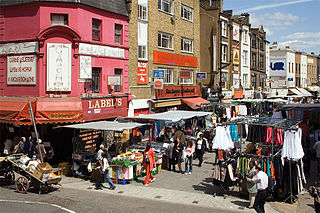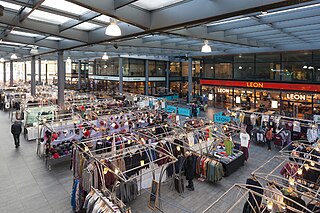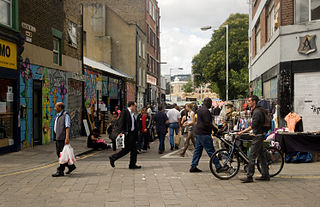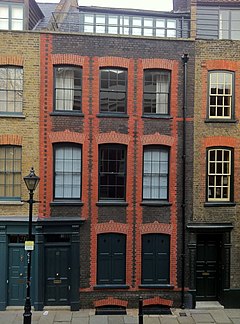
Bethnal Green is an area in the East End of London 3 miles (4.8 km) northeast of Charing Cross. Part of the area holds conservation area status, chiefly due to protected small, public greens and listed buildings. The area emerged from the small settlement which developed around the Green, much of which survives today as Bethnal Green Gardens, beside Cambridge Heath Road. By the 16th century the term applied to a wider rural area, the Hamlet of Bethnal Green, which subsequently became a Parish, then a Metropolitan Borough before merging with neighbouring areas to become the north-western part of the new London Borough of Tower Hamlets.

Commercial Street is an arterial road in Tower Hamlets, east London that runs north to south from Shoreditch High Street to Whitechapel High Street through the East End district of Spitalfields. The road is a section of the A1202 London Inner Ring Road and as such forms part of the boundary of the London congestion charge zone.

Spitalfields is a district in the East End of London and within the London Borough of Tower Hamlets. The area is formed around Commercial Street and includes the locale around Brick Lane, Christ Church, Toynbee Hall and Commercial Tavern. It has several markets, including Spitalfields Market, the historic Old Spitalfields Market, Brick Lane Market and Petticoat Lane Market. It was part of the ancient parish of Stepney in the county of Middlesex and was split off as a separate parish in 1729. Just outside the City of London, the parish became part of the Metropolitan Board of Works area in 1855 as part of the Whitechapel District. It formed part of the County of London from 1889 and was part of the Metropolitan Borough of Stepney from 1900. It was abolished as a civil parish in 1921.

Brick Lane is a street in the East End of London, in the borough of Tower Hamlets. It runs south from Swanfield Street in Bethnal Green, crosses Bethnal Green Road in Shoreditch, and enters Whitechapel; its south end is linked to Whitechapel High Street by the short stretch of Osborn Street. Today, it is the heart of the city's Bangladeshi community mostly made of Sylheti Bangladeshies and is known to some as Banglatown. It is famous for its many curry houses.

Petticoat Lane Market is a fashion and clothing market in Spitalfields, London. It consists of two adjacent street markets. Wentworth Street Market is open six days a week and Middlesex Street Market is open on Sunday only.

Christ Church Spitalfields is an Anglican church built between 1714 and 1729 to a design by Nicholas Hawksmoor. On Commercial Street in the East End and in today's Central London it is in the London Borough of Tower Hamlets, on its western border facing the City of London, it was one of the first of the so-called "Commissioners' Churches" built for the Commission for Building Fifty New Churches, which had been established by an Act of Parliament in 1711.

Dennis Severs' House in Folgate Street, London is a "still-life drama" created by Dennis Severs, who owned and lived in it until his death, as a "historical imagination" of what life would have been like inside for a family of Huguenot silk weavers. It is a Grade II listed Georgian terraced house in Spitalfields in the East End, Central London, England. From 1979 to 1999 it was lived in by Dennis Severs, who gradually recreated the rooms as a time capsule in the style of former centuries. Severs' friend Dan Cruickshank said: "It was never meant to be an accurate historical creation of a specific moment – it was an evocation of a world. It was essentially a theatre set."

The Black Eagle Brewery is the former brewing plant of Truman's Brewery located around Brick Lane in the Spitalfields area, in the London Borough of Tower Hamlets. Truman's subsequently became Truman, Hanbury and Buxton. By 1853, the Black Eagle Brewery was the largest in the world, with an annual production of 400,000 barrels.
A tenterground, tenter ground or teneter-field was an area used for drying newly manufactured cloth after fulling. The wet cloth was hooked onto frames called tenters and stretched taut so that the cloth would dry flat and square.
Huguenot Weavers were French silk weavers of the Calvinist faith. They came from major silk-weaving cities in southern France, such as Lyon and Tours. They fled from religious persecution, migrating from mainland Europe to Britain around the time of Revocation of the Edict of Nantes, 1685.
The Spitalfield riots occurred between 1765 and 1769, during a downturn in the silk weaving industry, centred on Spitalfields in the East End of London. The weavers organised to attempt to ensure that the rates of pay paid for their piece work was not cut beneath the level at which they could feed themselves, and their families.

The Machzike Hadath community synagogue is a Lithuanian synagogue founded in 1891.

Spitalfields Market is a traders' market as well as a food and art market located in Spitalfields, Central London. Traders began operating around 1666, after the Great Fire of London, where the market stands today. The Spitalfields regeneration programme that ended in 2005, resulted in two new public spaces – Bishops Square and Crispin Place, restoration of several historic streets and more independent retailers and restaurants. Spitalfields Market is situated in the London Borough of Tower Hamlets. It is surrounded by Lamb Street, Old Spitalfields market, Brushfield Street and Bishops Square.

The Ten Bells is a public house at the corner of Commercial Street and Fournier Street in Spitalfields in the East End of London. It is sometimes noted for its supposed association with two victims of Jack the Ripper, Annie Chapman and Mary Kelly.
Bangladeshis are one of the largest immigrant communities in the United Kingdom. Significant numbers of ethnic Bengali and ethnic Sylheti peoples arrived as early as the seventeenth century, mostly as lascar seamen working on ships. Following the founding of Bangladesh in 1971, a large immigration to Britain took place during the 1970s, leading to the establishment of a British Bangladeshi community. Bangladeshis were encouraged to move to Britain during that decade because of changes in immigration laws, natural disasters such as the Bhola cyclone, the Bangladesh Liberation War against Pakistan, and the desire to escape poverty, and the perception of a better living led Sylheti men bringing their families. During the 1970s and 1980s, they experienced institutionalised racism and racial attacks by organised far-right groups such as the National Front and the British National Party.

Brick Lane Jamme Masjid, formerly known as the London Jamme Masjid, is a Muslim place of worship in Central London and is in the East End of London. The building at 59 Brick Lane, on the corner of Fournier Street, has been home to a succession of Christian, Jewish, and Muslim communities since its construction in the mid-eighteenth century, reflecting the waves of immigration in the neighbourhood of Spitalfields. The former Great Synagogue is a Grade II* listed building; the adjacent former school buildings is listed Grade II.

Sandy's Row Synagogue is a historic Grade II listed synagogue and former Christian church in the East End of London. Built by refugee French Huguenots in 1766, it was later converted into a Baptist chapel and in 1867 was acquired by a Jewish congregation. It is the oldest surviving Ashkenazi synagogue in London.

The Coombe is a historic street in the south inner city of Dublin, Ireland. It was originally a hollow or valley where a tributary of the River Poddle, the Coombe Stream or Commons Water, ran. The name is sometimes used for the broader area around, in which the Poddle and its related watercourses featured strongly.

Brick Lane Market is a London market centred on Brick Lane, in Tower Hamlets in east London. It is located at the northern end of Brick Lane and in the heart of east London's Bangladeshi community. It operates every Sunday from around 9 a.m. to 5 p.m.

56 Artillery Lane is an 18th-century Grade I listed building in Spitalfields, London. The building is situated in the Artillery Passage, and was merged with the now Grade II listed building 58 Artillery Lane after the Second World War; their combined shop front is one of the oldest in London, and the combined building is used by Raven Row as a free art exhibition centre.






















